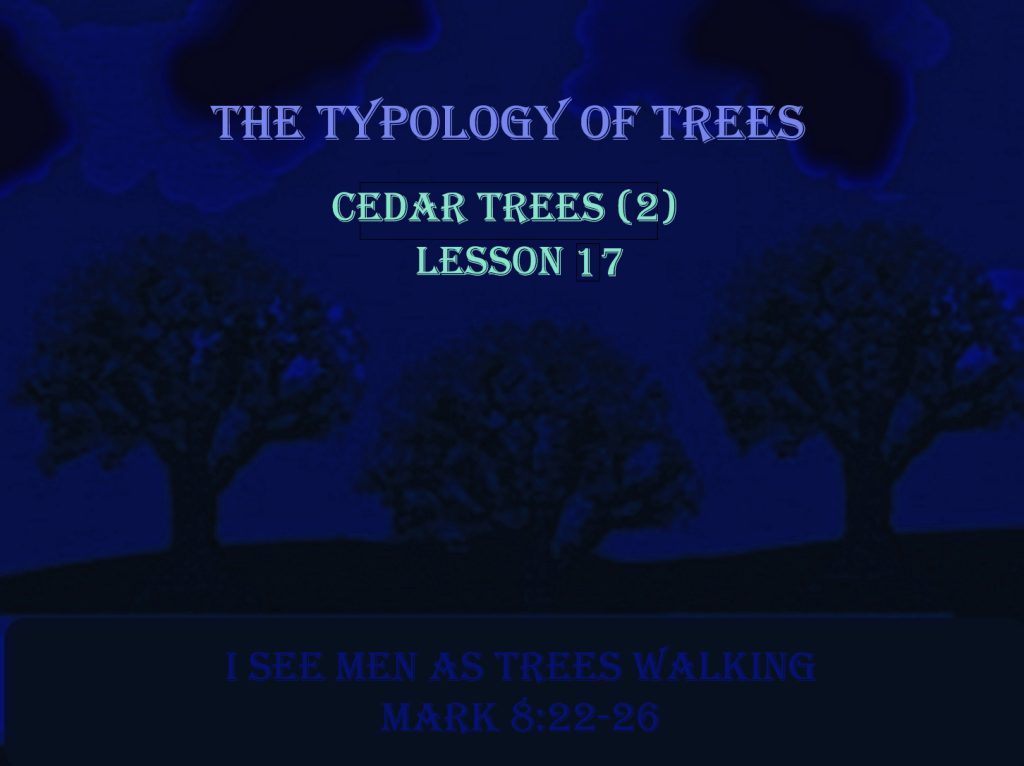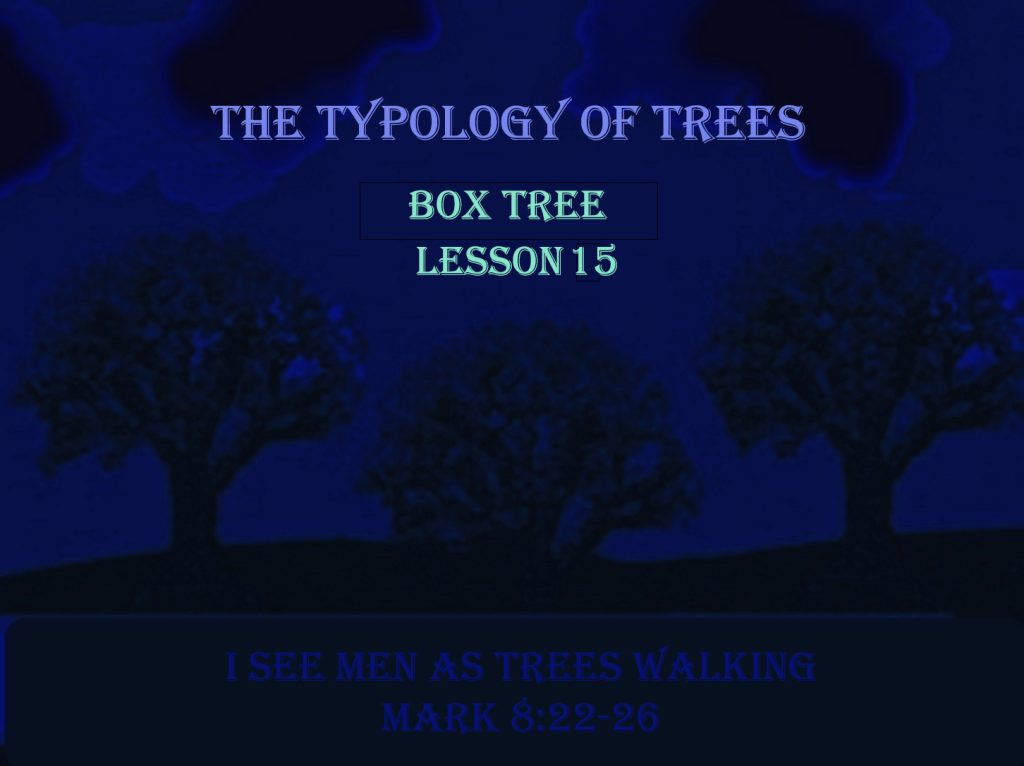
#18 – I See Men as Trees Walking – Chesnut Tree
Mark 8:22-26
(TY200 – Lesson 18)
By Kathy L McFarland
8/01/2024
The Mysteries of Trees
Mark 8:22–26 (KJV 1900)
22 And he cometh to Bethsaida; and they bring a blind man unto him, and besought him to touch him. 23 And he took the blind man by the hand, and led him out of the town; and when he had spit on his eyes, and put his hands upon him, he asked him if he saw ought. 24 And he looked up, and said, I see men as trees, walking. 25 After that he put his hands again upon his eyes, and made him look up: and he was restored, and saw every man clearly. 26 And he sent him away to his house, saying, Neither go into the town, nor tell it to any in the town.
TY200 – INTERPRETATION CONFIDENCE CHART
- Typology known as fully God’s Truth concerning trees walking as recorded in Mark 8:22-26 (Those specifically, typologically identified in Scripture)
- Trees in Scripture identify the different Spiritual Lives that are lived on this Earth
- Different parts of the trees walking with Christ are fully represented in Scripture as God’s Truth
- Tree – Spiritual Lives of forgiven followers walking with the Lord Jesus Christ and producing powerful fruits of His.
- Root – The foundation of a tree from firstfruit that is secured by a lump of clay that can grow and produce living works of fruit
- Leaves – The preparation that LORD God makes for the coming events of living works.
- Fruit – Living works of the LORD God, done through followers (Branch) of the Lord Jesus Christ (Vine) at the guidance of the Holy Spirit with the spiritual life of a walking tree.
- Seed – Word of God.
- The fruit of righteousness is a Tree of Life.
- Cedar Tree – Spiritual life defines politically, worldly, and socially powerful leaders with spiritual hints of (righteous or wicked) strength whose height is far beyond regular people. They are political superstars with religious overtones throughout their persona. They can start their growth as righteous or secular; but eventually take on spiritual overtones and end up wicked. When one man assumes that great of power, then the spiritual side with the LORD God and the Lord Jesus Christ and their Holy Spirit is denied eventually. To gain such great power over people requires astute political manipulative control over their world with hints of divine empowerment; most often, that powerful of a man or woman leader realizes the need for appearances that “God is on their side,” whether it be for war or rule or privilege. So just as Lucifer dipped his roots into the biggest “flowing grace of God” river so do those that want to be ultimate ruler. It means nothing if their soul is measured. But it means everything to trick the masses and gain the power necessary to rule the world.
- Righteous Cedar Tree – The Spiritual Life that is beautiful, politically, and socially powerful, more spiritual growth than all the other trees, many protected followers. Can be goodly and righteous; but risks becoming a tyrant with a very thin line dividing righteousness from wickedness. They must have the shittah, myrtle, and oil trees surrounding them so they can see, know, consider, and understand, to maintain their righteous state.
- Unrighteous Cedar Tree – The Spiritual Life of a tyrant. He lifts himself in height, he shoots up his top among the thick boughs, and his heart lifts in his height. He is all-powerful but wicked, with no Christian support surrounding him.
- Typology Known Confidently (Those represented in Scripture with enough frequency, sufficiency, and accuracy to reveal their typological meanings with full Truth of God unchallenged and supported by the Holy Spirit’s teachings)
- Almond Tree – The believer, as an almond tree, is a Christian leader, chosen by God, that watches over the works of Christians guided by the Lord, and the people he serves.
- Algum/Almug Tree – The Spiritual Life works that honors the LORD God and guides Believers to come closer to Him toward the beauty of His Holiness through the Lord Jesus Christ. Musical worship and high praise are often expressed through these types of Christian works.
- Apple Tree – A Spiritual Life that can comfort those that love God, regardless of their status of sin. These Spiritual works provide protection, sweetness of life; the Christians doing these works are often beloved amongst the worldly receivers. (Believers from the Salvation Army, Catholic Charities, Lutheran, Baptist, and Methodist Social Services, and other Missionary and denominational efforts to house the homeless, feed the hungry, and provide comfort in despair are excellent examples of this type of spiritual lives lived in duty toward their works for God.)
- Ash Tree – A Spiritual Life with a deceived heart, that stands among places of Christians and worships different false gods created by other human beings or self.
- Typology Known Probably (Knowledge of Scripture, God’s Way, Logic and common sense in the typological meaning can NOT be confirmed fully with the Word of God and the moving of the Holy Spirit)
- Bay Tree – Native spiritual life that develops naturally.
- Fake Bay Tree – Imitation spiritual life forced upon believers through powerful coercion, trickery, evil, or control.
- Box Tree – Spiritual life that stands in the midst of dryness. The location the Box Tree stands is empty of both worldly people and the flowing grace of the LORD God. Here stands the lonely Christian as a beacon for the uncommon seeker of God. Eventually, the Box Tree is combined with the other beautiful spiritual life souls that serve in the world and in the dry places and perform ministry guided by the Holy Spirit and coming together in the Sanctuary of the Lord. A possible identity of a Box Tree is a missionary that serves in extreme conditions with few common people, the lack of Christian presence and the lack of the movements of God.
- Typology NOT Known (Can NOT make even simple assumptions of the typological meaning because there is NOT enough frequency, sufficiency, or accuracy recorded in Scripture, and the Holy Spirit is NOT teaching deeper meaning)
- Chesnut Tree – It is NOT necessarily a beautiful spiritual life but serves a distinctive purpose in the spiritual world. (Uncertain of typology)
Genesis 30:37–39 (KJV 1900)
37 And Jacob took him rods of green poplar, and of the hazel and chesnut tree; and pilled white strakes in them, and made the white appear which was in the rods. 38 And he set the rods which he had pilled before the flocks in the gutters in the watering troughs when the flocks came to drink, that they should conceive when they came to drink. 39 And the flocks conceived before the rods, and brought forth cattle ringstraked, speckled, and spotted.
1. Green poplar, hazel, and chesnut trees can all be made into rods.[1]
Rods – 5234 מַקֵּל (mǎqꞏqēl): n.masc. and fem.; ≡ Str 4731; TWOT 1236—1. LN 3.47–3.59 branch, twig-stick, i.e., a part of a plant that extends from the body of a plant or tree, which can be removed from the tree (Ge 30:37,38, 39, 41; 1Sa 17:43; Jer 1:11; Hos 4:12+); 2. LN 6.29–6.40 wood club, i.e., a stout piece of wood used as a weapon (Eze 39:9+); 3. LN 6.215–6.225 staff, i.e., a long stick carried in the hand for various functions, including a walking helper, or shepherds tool, or symbol of rulership (Ge 32:11[EB 10]; Ex 12:11; Nu 22:27; 1Sa 17:40; Jer 48:17; Zec 11:7, 10,14+)[2]
3. The rod can be made into a long stick carried in the hand for walking, shepherds’ tool, or symbol of rulership.
4. But Jacob had another use for three rods. He pilled white strakes in the rods, showing the white inside them.
Pilled – 7202 פָּצַל (pāꞏṣǎl): v.; ≡ Str 6478; TWOT 1797—LN 19.27–19.33 (piel) debark, i.e., peel bark off a plant or tree, i.e., tear a layer off something (Ge 30:37, 38+) פְּצָלָה (peṣāꞏlā(h)) BDB: see 7203.[3]
Strakes – 7203 פְּצָלוֹת (peṣāꞏlôṯ): n.fem.pl.; ≡ Str 6479; TWOT 1797a—LN 3.47–3.59 peelings, i.e., a thin outer layer of organic material taken off plants or fruits of plants (Ge 30:37+), note: in context a “white stripe” pattern was possibly made from these peelings.[4]
5. When the bark was peeled from the green poplar, hazel, and chesnut trees, white stripes appeared on each of the rods.
6. Jacob placed the white striped rods into the gutters of the watering trough. The pure white cattle, goats and sheep that drank from that trough conceived before the rods.
7. They conceived ringstraked, speckled, and spotted sheep.
Ringstraked – 6819 עָקֹד (ʿāꞏqōḏ): adj.; ≡ Str 6124; TWOT 1678a—1. LN 79.26–79.38 (BDB, most versions) streaked, striped, i.e., pertaining to an alternating color pattern of stripes or less distinct linear discolorations (Ge 30:35, 39, 40; 31:8,10, 12+); note: (NKJV) speckled; note: for another interp, see next; 2. LN 79.88–79.90 (KB, Holladay) curly, i.e., pertaining to having a curly, crooked appearing tail on an animal, as a distinguishing mark, as a feature of an object (Ge 30:35, 39, 40; 31:8,10, 12+), note: context favors the meaning as a color pattern of some kind, see prior entry[5]
Speckled – 5923 נָקֹד (nāꞏqōḏ): adj.; ≡ Str 5348; TWOT 1410a—LN 79.26–79.38
speckled, spotted, i.e., pertaining to a variegated color pattern on an animal, either
specks or spots of dark on light or vice versa (Ge 30:32,33, 35, 39; 31:8,10, 12+)[6]
Spotted – 3229 טָלָא (ṭāꞏlā(ʾ)): v.; ≡ Str 2921; TWOT 805—LN 79.114–79.117 (qal pass. as a) see 3231.5; (pual) be patched, i.e., pertaining to being covered over with another newer piece of material (Jos 9:5+)[7]
8. No Theologist or Bible teacher fully understands why this happens; it is an unknown process. But what we know for sure is that Jacob increased his flock greatly by taking the different distinctly colored goats and sheep rather than the pure white ones.
Ezekiel 31:1–11 (KJV 1900)
And it came to pass in the eleventh year, in the third month, in the first day of the month, that the word of the Lord came unto me, saying, 2 Son of man, speak unto Pharaoh king of Egypt, and to his multitude; Whom art thou like in thy greatness? 3 Behold, the Assyrian was a cedar in Lebanon with fair branches, and with a shadowing shroud, and of an high stature; and his top was among the thick boughs. 4 The waters made him great, the deep set him up on high with her rivers running round about his plants, and sent out her little rivers unto all the trees of the field. 5 Therefore his height was exalted above all the trees of the field, and his boughs were multiplied, and his branches became long because of the multitude of waters, when he shot forth. 6 All the fowls of heaven made their nests in his boughs, and under his branches did all the beasts of the field bring forth their young, and under his shadow dwelt all great nations. 7 Thus was he fair in his greatness, in the length of his branches: for his root was by great waters. 8 The cedars in the garden of God could not hide him: the fir trees were not like his boughs, and the chesnut trees were not like his branches; nor any tree in the garden of God was like unto him in his beauty. 9 I have made him fair by the multitude of his branches: so that all the trees of Eden, that were in the garden of God, envied him. 10 Therefore thus saith the Lord God; Because thou hast lifted up thyself in height, and he hath shot up his top among the thick boughs, and his heart is lifted up in his height; 11 I have therefore delivered him into the hand of the mighty one of the heathen; he shall surely deal with him: I have driven him out for his wickedness.
9. Chesnut trees do not have beautiful branches.
Teachings of Kathy L McFarland
Oh, how I wish I could teach you more. The typology of the chesnut tree is vague, and I do not have total confidence in its deeper meaning. My educated guess is that the chesnut tree is not necessarily a beautiful spiritual life but serves a distinctive purpose in the spiritual world. I will go with that for now and place it in the “Typology Known Not.” It will be one of those deeper meanings that I hope one day to know.
[1] The rod is a branch off a tree which can be removed from the tree without killing it
[2] James Swanson, Dictionary of Biblical Languages with Semantic Domains : Hebrew (Old Testament) (Oak Harbor: Logos Research Systems, Inc., 1997).
[3] Ibid.
[4] Ibid.
[5] Ibid.
[6] Ibid.
[7] Ibid.



